Following up from the recently published IPv6 RIPEness update, we are now looking at the IPv6 RIPEness of Local Internet Registries relative to their age and relative to their size.
In a recent RIPE Labs article, IPv6 RIPEness - Production & Updates , we were happy to report that it has been decided to make IPv6 RIPEness a production service. This means we will continue to award Local Internet Registries (LIRs) that fulfil all four IPv6 RIPEness criteria (also referred to as 'stars') by listing them on a public web side. We will also continue to look at the increase of IPv6 RIPEness in individual countries and in the RIPE NCC service region as a whole.
The previous article concluded with the observation that 46% of all LIRs in the RIPE NCC service region now has one or more stars of IPv6 RIPEness. Although we did not reach 50% yet, the number of LIRs that have an IPv6 allocation continues to grow - in absolute terms as well as in percentages. We were interested to find out how IPv6 RIPEness is distributed across the membership. Do new LIRs pick up IPv6? Are older LIRs, those with more experience and with a more established business and customer base, dominating IPv6 RIPEness scores? And what about the size of an LIR? Are small and large adopting IPv6 in equal proportions? And how has this changed since last year when we published statistics answering some of these questions in the article IPv6 RIPEness - the Sequel ?
IPv6 RIPEness compared to the LIR's age
To investigate the relation between IPv6 RIPEness and an LIRs' age, we first grouped the LIRs by the year they became members of the RIPE NCC. We then determined the relative IPv6 RIPEness scores for each year. Figure 1 below shows the result. As in previous articles, the colours in each bar represent the fractions of LIRs with specific values of RIPEness:
- yellow = 1 star
- orange = 2 stars
- light green = 3 stars
- dark green = 4 stars
- grey = no IPv6
The width of each bar is representative for the number of LIRs who joined in that year.

Figure 1: Relative distribution of IPv6 RIPEness, related to age of LIR, sorted by year
IPv6 RIPEness is fairly evenly distributed over the years. From 2006 to 2010, we see a little more than 40% of the LIRs that joined during this particular year has one or more stars. For 2011, the fraction of LIRs with 3 and 4 stars is notably lower. Obtaining IPv6 address space, registering route objects and setting up reverse DNS does not seem to be the first priority for newcomers. Still, it is encouraging to see that in total already 33% have an IPv6 allocation.
For the years 1996 to 2005 the distribution fluctuates more, although the overall trend is for LIRs to have a higher IPv6 RIPEness the longer they have been a RIPE NCC member. Note that these years also include the early adopters: LIRs that obtained IPv6 space several years ago (see more information about this in the RIPE Labs article: Interesting Graph - IPv6 Allocations since 1999 ). We see this observation confirmed in Figure 2 which shows the distribution of IPv6 RIPEness relative to the LIR's age as it was exactly two years ago, on 1 November 2009.

Figure 2: Relative distribution of IPv6 RIPEness, related to age of LIR (status: 1 Nov 2009)
Since 2009, the IPv6 RIPEness of all LIR age groups has gone up by roughly 20%. Those years leading now, were also ahead in 2009. Most notably, the oldest LIRs (established in 1995) have been and still are leading the pack. 80% of these LIRs have IPv6 space and 53% score all four stars of RIPEness. Although the relatively small size of the 1995 group of LIRs makes it easier to obtain a high fraction of RIPEness, this is not the only factor. The LIRs established in 1996, 1997 and 1998, are of comparable size, but still the LIRs from 1995 are most "IPv6 RIPE".
If we look at the absolute number of LIRs grouped by the quarter they became members (see Figure 3), we see the pattern even more clearly. The oldest LIRs really stand out in IPv6 RIPEness. The reason is likely that this group is composed of Internet pioneers: those ISPs and academic networks operators that helped the Internet take off in Europe. These LIRs have in large majority recognised the need to deploy IPv6.
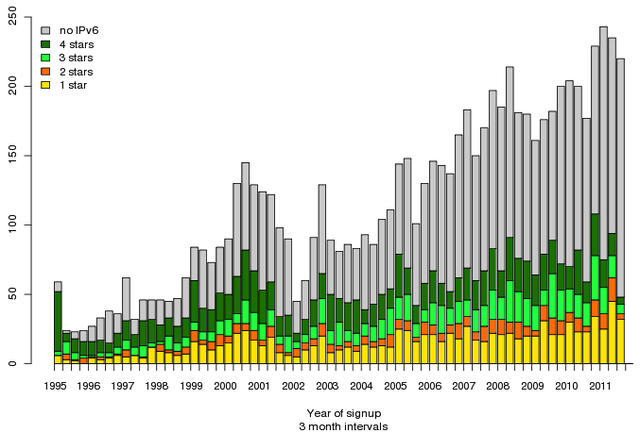
Figure 3: Distribution of IPv6 RIPEness, related to age of LIR, sorted by quarter
On the other side of the spectrum it becomes clear that the status of new LIRs, those who joined in 2011, is even better than the grouping by year suggests. It is only the very last quarter, the group of LIRs who just started, which falls behind in IPv6 RIPEness. LIRs who joined in the first half of 2011 are well on their way; a good number already have 4-star RIPEness.
IPv6 RIPEness compared to the LIR's size
In Figure 4 below, we look at the distribution of IPv6 RIPEness related to the size of the LIR. The size is determined by the billing category of the LIR (starting with XL on the left and ending with XS on the right hand side of the graph).This quite clearly shows that large and extra large LIRs have a higher rate of IPv6 RIPEness. One reason for this is that due to the smaller size of the category, it is takes less adopters to reach a high score. At the same time we can expect larger LIRs to be more aware of the need to deploy IPv6 for long term business growth. And since roll out of IPv6 in large networks will take more time, the larger LIRs may have requested IPv6 space early.
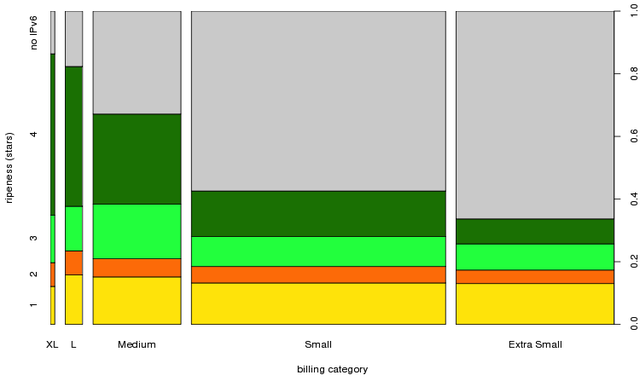
Figure 4: Distribution of IPv6 RIPEness, related to LIR size or billing category
Please keep in mind, that there is also a correlation between age and size: New LIRs tend to start as small or extra-small members and grow over time into bigger categories. That means larger LIRs are typically also members for a longer time. And pretty much all organisations that became a RIPE NCC member in 2011 are in the extra-small category.
Conclusion
From this recent analysis of IPv6 RIPEness in comparison with the age and the size of LIRs, we can conclude that the older and bigger LIRs tend to score higher in IPv6 RIPEness. This might not be surprising: older LIRs had more time to prepare for the adoption of IPv6. However, we also see new LIRs are picking up IPv6 relatively quickly. Only those LIRs that joined in the last quarter score lower and it is to be expected that they will increase their IPv6 RIPEness score soon.

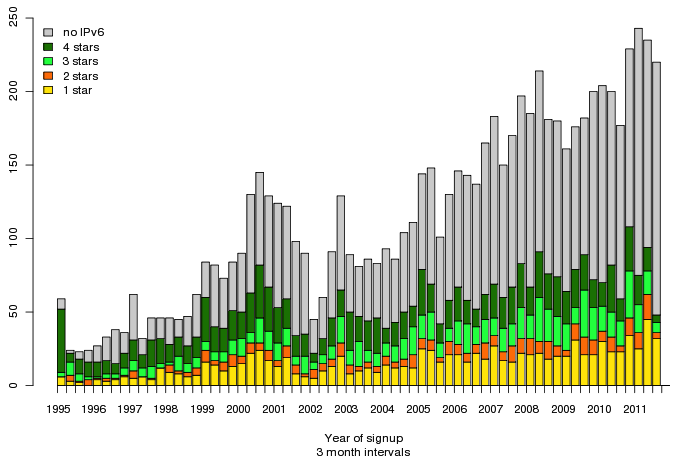





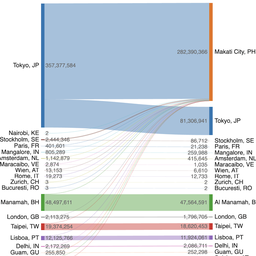
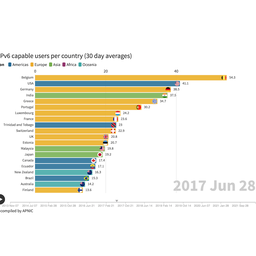

Comments 2
The comments section is closed for articles published more than a year ago. If you'd like to inform us of any issues, please contact us.
Carlos Friacas •
It seems some scripts are not running properly at ripeness.ripe.net (see http://ripeness.ripe.net/pies.html)
Emile Aben •
Hi Carlos, Thanks for notifying us, scripts are currently rerunning, and ipv6ripeness.ripe.net/pies.html shows valid data now, just a couple days old. Later today it should be showing yesterdays data.